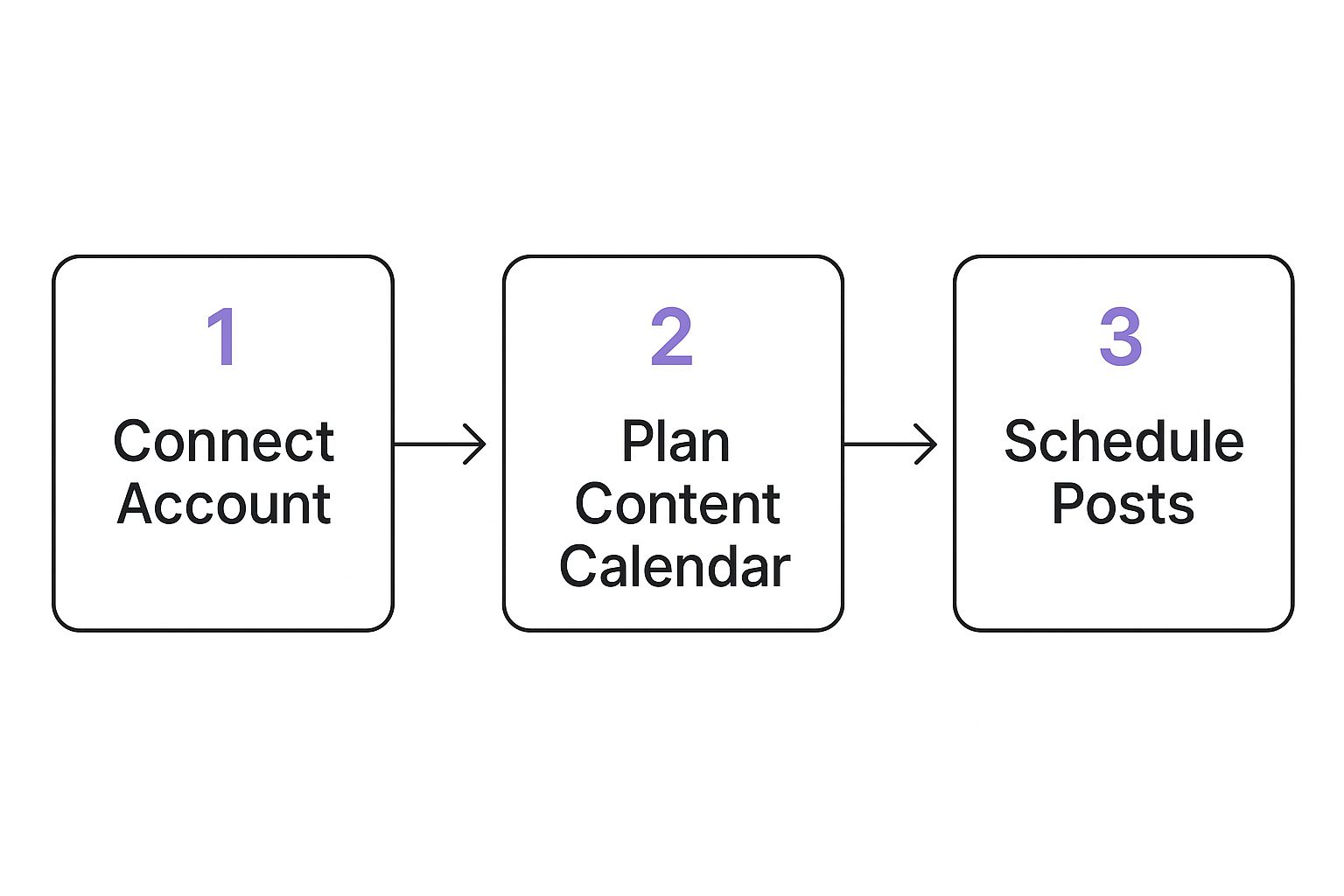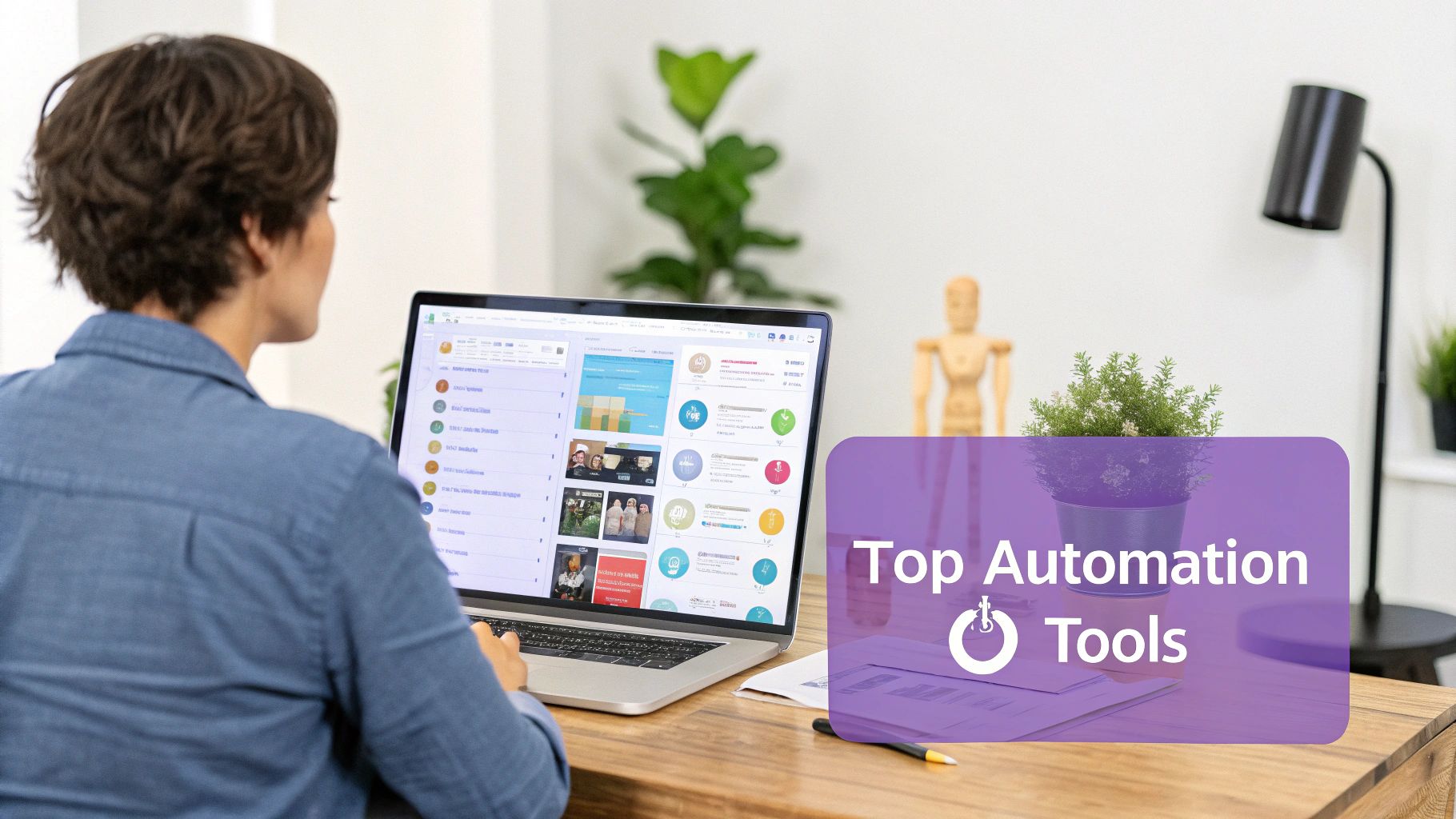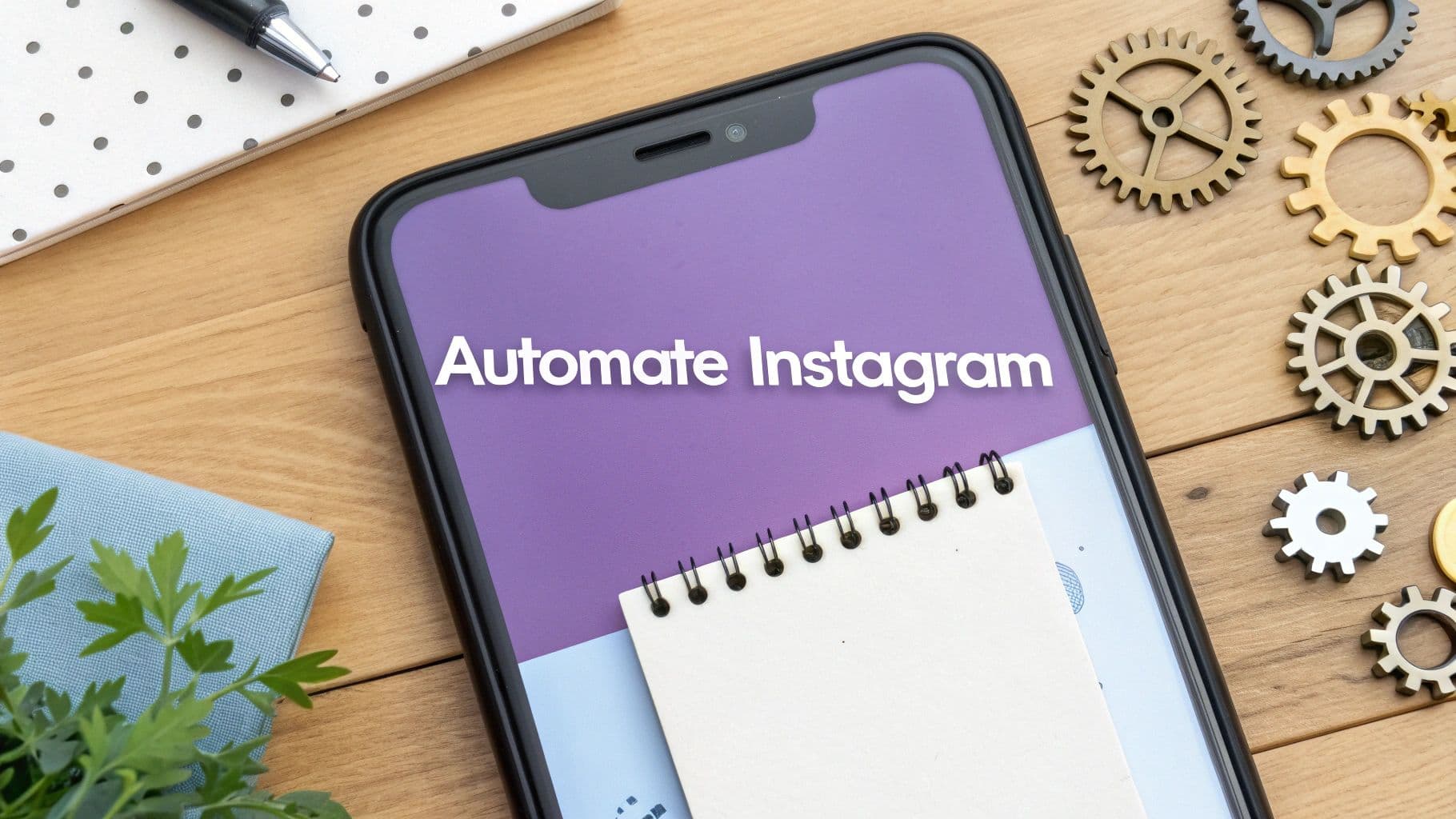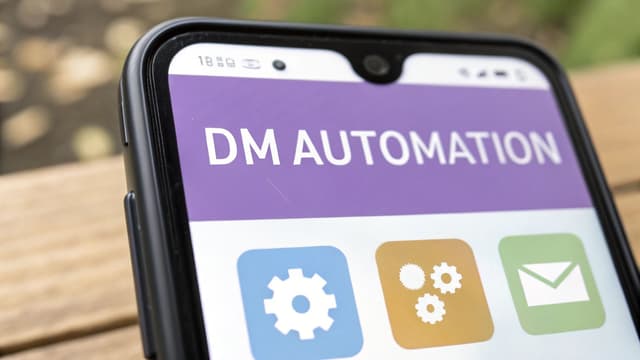Why Smart Instagram Automation Beats Manual Management

Let's be honest: trying to manually keep up with a growing Instagram account can feel like a recipe for burnout. The endless cycle of posting, replying to every comment, and staying on top of DMs is a huge challenge for any team. This is exactly why the idea to Instagram automation tips moves from being a "nice-to-have" to a fundamental part of a smart business plan.
But there’s a world of difference between intelligent automation that reflects your brand’s voice and a clunky, robotic system that drives followers away. Real success comes from using tools to handle repetitive work with precision, which frees up your team to focus on building genuine, high-value relationships with your audience.
The Growing Challenge of Manual Engagement
As your follower count grows, the number of DMs, comments, and story replies you receive doesn't just increase—it explodes. What was once a manageable part of your day can quickly turn into a flood of notifications that's impossible to handle. This is the reality of engaging on a platform with 2 billion active users.
This growth forces a decision: either hire more people just to keep up with the inbox, or find a way to work smarter. With nearly 29% of users now making purchases directly through the app, a slow response time means you're actively leaving sales on the table. A well-designed automated system works for you 24/7, making sure you never miss those opportunities. You can see the full breakdown of Instagram user data to understand the scale of this opportunity.
Defining 'Smart' Automation
So, what does 'smart' automation actually look like? It’s about adding real value, not just creating more noise. It's the difference between a bot leaving a generic "Great post!" comment and an AI-powered agent that instantly answers a specific question about product availability in a DM.
Think of it as creating a super-efficient, always-on assistant for your brand. For an e-commerce store, this could be a workflow that recognizes a comment like "How much is this?" on a product post. It can then automatically send a helpful DM with the price, details, and a direct link to the checkout page. This is a far cry from the spammy auto-follow bots that can seriously damage your brand's credibility.
To really see the difference, let's break down how a manual approach stacks up against smart automation in the real world. The table below compares the time investment, consistency, and results between these two management styles.
Instagram Automation Benefits vs. Manual Management Comparison of time investment, consistency, and results between automated and manual Instagram management approaches
| Management Aspect | Manual Approach | Automated Approach | Time Saved |
|---|---|---|---|
| Time Commitment | High, daily effort required for every interaction | Low after initial one-time setup | 10-15 hours/week |
| Consistency | Prone to human error, burnout, and missed posts | 24/7 flawless consistency in responses and actions | N/A |
| Lead Response | Slow, often delayed by hours or even days | Instantaneous, real-time replies that capture leads | N/A |
| Scalability | Limited by team size, budget, and working hours | Nearly infinite, handles any volume of interactions | N/A |
The data makes it clear: automation doesn't just save time; it creates opportunities that are impossible to capture manually.
Ultimately, the goal here isn't to replace your team, but to give them superpowers. By letting automation handle the predictable, high-volume tasks, you allow your social media managers to focus on what people do best: creating incredible content, building a real community, and analyzing performance to make your strategy even better.
This shift transforms their role from a reactive, firefighting function into a proactive growth driver for your business. It's a change that not only makes your operations more efficient but also boosts team morale by letting them work on more creative and fulfilling projects.
Building Your Instagram Automation Foundation That Lasts
It’s tempting to dive headfirst into automation tools, but going in without a plan is like building a house with no blueprint. The secret to making automate Instagram a core part of your growth is to lay the proper groundwork first. This preparation is what separates accounts that see incredible growth from those that just add to the noise or, worse, get flagged for spammy activity. A solid foundation makes sure your automation is smart, sustainable, and actually helps you hit your business targets.
Perform a Reality Check with an Automation Audit
Before you can improve your workflow, you have to know what isn’t working. An automation audit is simply a close look at your current Instagram performance to spot the biggest gaps and opportunities. This isn’t about vanity metrics like follower counts. You need to look at your average DM response times, how consistently you post, and what kind of content sparks real conversations—not just likes, but saves, shares, and meaningful comments.
You can start by gathering this data directly from your native analytics dashboard.
 Think of these performance insights as a treasure map. They point directly to the areas where a little automation can make a huge difference in your efficiency and bottom line.
Think of these performance insights as a treasure map. They point directly to the areas where a little automation can make a huge difference in your efficiency and bottom line.
For instance, let’s say your audit shows that questions about products in your comments sit unanswered for hours. That’s a perfect opportunity. You can build a simple workflow that spots keywords like “price” or “how much” and immediately sends the user a helpful DM. That one small change can have a direct effect on your sales, even while you’re offline.
Create Content Systems for Automated Publishing
Automation thrives on consistency; you can’t automate a chaotic content process and expect great results. This is exactly why building a content framework is so important. Instead of scrambling for post ideas every day, you can define a few core content themes that connect with your audience. From there, you can batch-create your content—writing captions, designing graphics, and editing videos—for a full week or even a month in one sitting.
This infographic breaks down the simple but effective process a content system makes possible.
 Following this flow, from connecting your account to planning and scheduling, is the backbone of a low-stress, high-impact Instagram automation plan.
Following this flow, from connecting your account to planning and scheduling, is the backbone of a low-stress, high-impact Instagram automation plan.
This methodical approach gives your scheduling tool a constant supply of quality posts, which helps you maintain a solid presence. To make sure your brand voice stays consistent and doesn't sound robotic, you should:
- Develop a library of pre-written DM responses for frequently asked questions.
- Create clear guidelines for your tone, emoji use, and hashtags.
- Establish a quick final review before any content is scheduled to go live.
This prep work is what makes your automated posts feel authentic and perfectly on-brand.
Choosing Instagram Automation Tools That Actually Deliver
 Once your strategy is set, you face the tough part: sifting through the sea of platforms that all promise to automate Instagram for you. Let's be honest, many of these tools are just polished money pits. A select few, however, can become a genuine game-changer for your business. The secret isn't just about picking one tool; it's about building a smart toolkit that matches your specific goals and stage of growth.
Once your strategy is set, you face the tough part: sifting through the sea of platforms that all promise to automate Instagram for you. Let's be honest, many of these tools are just polished money pits. A select few, however, can become a genuine game-changer for your business. The secret isn't just about picking one tool; it's about building a smart toolkit that matches your specific goals and stage of growth.
Differentiating Between Tool Types
It's easy to think all automation platforms do the same thing, but they don't. Some are fantastic for scheduling your content calendar weeks in advance, while others excel at managing a flood of DMs. A common trap is searching for one magical tool that does everything perfectly. Instead, think like a specialist and build a custom toolkit.
For instance, you could use one platform to schedule your feed posts and Reels, and then pair it with a dedicated Instagram DM automation tool to handle customer questions with AI. This approach ensures you get top-tier performance for every job, from publishing content to closing sales directly in your DMs.
This shift toward specialized tools is changing how brands manage their presence online. The best platforms now offer a powerful combination of scheduling, engagement automation, and in-depth analytics. Automating tasks like auto-publishing posts or answering frequently asked questions frees up your team to focus on bigger-picture strategy. This is essential for maintaining a consistent and professional brand voice on a platform so vital for visibility. You can explore more on these tool capabilities here to see what's possible.
Red Flags That Signal a Risky Platform
As you search for the right tools, you'll come across some that could get your account into serious trouble. These are the platforms to run away from, fast. The biggest red flag is any service that promises to inflate your follower count using automated actions that are obviously not human.
Be extremely cautious of any tool that offers to:
- Auto-follow and unfollow accounts.
- Automatically like posts based on certain hashtags.
- Post generic, automated comments on other people's content.
These tactics are clear violations of Instagram's Terms of Service. Using them is the quickest route to having your account's reach crushed, getting temporarily suspended, or even permanently banned. Real automation is about working smarter and providing better service—not faking engagement. To find solutions that focus on safe and effective growth, check out this article on Top Social Media Automation Tools. Your brand’s reputation is on the line, so choose wisely.
Mastering Content Scheduling Without Losing Your Soul
Posting consistently is essential on Instagram, but the pressure to be "on" 24/7 can quickly drain your creative energy. To truly succeed with Instagram automation, you need a system that works for you, not one that turns you into a content machine. This is exactly how top creators keep their feeds fresh and engaging, saving them several hours each week without sacrificing quality.
Advanced Scheduling Strategies
Let's think bigger than just picking a time and hitting "schedule." True efficiency comes from being more strategic. Smart creators often plan their content around thematic series, which builds excitement and gives followers a reason to come back. They also align their Instagram Stories to support their main feed posts, creating a unified narrative that pulls their audience deeper into their world.
The single biggest time-saver is batching your content creation. Instead of the daily scramble for a new post idea, dedicate one day to plan, write, and design everything for the next two or three weeks. This focused workflow populates your automated schedule, so you're never left wondering what to post. You can even map out an entire quarter's worth of major themes this way, while still leaving space to jump on new trends.
To make the most of your batched content, timing is everything. Posting when your audience is most active can dramatically increase your reach and engagement. While every account is different, certain patterns have emerged across industries.
To give you a data-backed starting point, we've put together a table of recommended posting times.
Optimal Posting Times by Industry and Content Type
Data-driven posting schedule recommendations based on engagement patterns across different industries and content formats
| Industry | Best Posting Days | Peak Hours | Content Type | Engagement Rate |
|---|---|---|---|---|
| Fashion & Apparel | Wednesday, Friday | 12 PM - 3 PM | Reels, Carousels | 4.5-6% |
| Food & Beverage | Tuesday, Friday | 11 AM - 1 PM | Reels, User-Generated | 3.8-5.2% |
| Tech / SaaS | Tuesday, Thursday | 9 AM - 11 AM (EST) | Infographics, Case Studies | 2.5-4% |
| Fitness & Wellness | Monday, Wednesday | 7 AM - 9 AM, 5 PM | Workout Videos, Tips | 4-5.5% |
| Travel & Hospitality | Friday, Sunday | 1 PM - 4 PM | High-res Photos, Stories | 5-7% |
Keep in mind that these are general guidelines. The best way to perfect your schedule is to dive into your own Instagram Insights and see when your followers are most active. Use this table as your launchpad, then fine-tune based on your own data. For strategies on how to turn your Reels into revenue streams, check out our Instagram Reels monetization guide.
Building a Safety Net for Your Content
A common worry with scheduling posts in advance is that you might accidentally post something that's tone-deaf or irrelevant due to a sudden change in current events. That's where a simple quality control process becomes your secret weapon. A quick final look before a post goes live can prevent a major brand headache. When choosing a tool, look for an Instagram Scheduler that gives you a clear, visual overview of your entire queue.
A good system is also a flexible one; a rigid calendar is fragile. Here’s how you can build in some agility:
- Leave a few "wildcard" slots open in your weekly schedule. This is your dedicated space to share content around trending audio or react to something happening in real-time.
- **Keep a drafts folder of "evergreen" content.
- Review competitor or user-generated content by capturing it discreetly with our screenshot stealth tips.** This is your backup stash of posts—like timeless tips or fun facts—that can be swapped in at a moment's notice if a scheduled post no longer feels right.
- Do a weekly queue review. Set a five-minute calendar reminder every Friday to scan the upcoming week’s posts. This simple habit ensures your content always feels timely and relevant.
This approach changes scheduling from a repetitive task into a strategic part of your workflow. It creates the consistency you need to grow while preserving the freedom to be spontaneous. Once your content publishing is running like a well-oiled machine, you can apply the same smart automation principles to your direct messages. To explore that, check out our guide on how to automate Instagram DMs.
Automating Engagement While Building Real Relationships

Let's be real, scaling your Instagram engagement can feel like an impossible balancing act. How do you reply to everyone without coming across as a cold, unfeeling robot? The solution isn't to throw your hands up and ignore people. It's about using Instagram automation as a smart strategy to build stronger customer connections.
Think of it as freeing up your team from the endless, repetitive queries so they can jump into the conversations that really count. This approach is what separates a brand that feels helpful from one that just feels spammy.
What to Automate vs. What to Keep Human
The secret to making automation work is knowing exactly what to hand off to your AI assistant and what requires a human touch. It’s like creating a triage system for your inbox. Your bot gets the high-volume, low-complexity tasks, while your team handles the rest.
Here’s what you can confidently automate:
- Keyword-triggered replies: When someone comments "link" or "price," your bot can instantly shoot them a DM with the details.
- Frequently Asked Questions: Handle common queries like, "What are your business hours?" or "Do you ship internationally?" without any human intervention.
- Story Mention Acknowledgements: Automatically send a quick "Thanks for the share!" DM when someone tags you in their Story. It’s a simple, effective way to show appreciation.
And here’s what needs a real person:
- Customer Complaints or Negative Feedback: These moments need genuine empathy and creative problem-solving, something a bot just can't fake.
- In-depth Product or Service Questions: When a customer asks complex questions that aren't in your FAQ, a team member needs to provide a detailed, helpful answer.
- Nurturing High-Value Relationships: Conversations with potential partners, influencers, or VIP customers should always be personal and handled with care.
Crafting Automated Responses That Don't Sound Robotic
The number one fear people have with automation is damaging their brand's hard-earned reputation. But a well-designed automated message feels helpful, not mechanical. The key is authenticity. Your automated replies should sound like they're coming from you. If your brand is casual and uses emojis in posts, your automated DMs should reflect that same voice.
A fantastic tip is to always give users an "escape hatch." This is a clear way for them to bypass the bot and talk to a human. For instance, your welcome message could say, "Hey {{first_name}}, thanks for reaching out! Our bot can help with quick questions, but if you'd rather chat with a person, just type 'human' and we'll connect you." This simple move sets clear expectations and gives the user control. We dive deeper into these techniques in our guide on how to automate Instagram DMs.
When you combine this smart engagement strategy with content automation, you create a well-oiled machine. By using tools to automatically schedule Instagram posts, you ensure a steady stream of content without the daily scramble. This combination of automated publishing and initial engagement frees up your team to do what they do best: build the genuine, lasting relationships that truly grow your business.
Turning Instagram Automation Into Measurable Business Growth
Once the technical setup is handled, it’s time to talk about what really matters: connecting automation to your bottom line. For smart businesses, the real power to automate Instagram isn't just about saving a few hours; it's about building a system that actively drives growth. This means going beyond simple post scheduling to use automation for generating leads, increasing sales, and building a loyal community.
Let's explore how to create automated funnels that turn casual followers into paying customers and deliver real, measurable business results.
From Likes to Leads: Building Your Automated Funnel
An automated funnel is essentially a pre-built journey that guides potential customers from the moment they discover you to the point they make a purchase. It’s a strategic workflow designed to anticipate their questions and needs.
Imagine you're an e-commerce brand launching a new skincare product via an Instagram Story ad. A potential customer sees the ad and sends a DM asking, "Is this good for sensitive skin?" Instead of making them wait for a manual reply, an automated workflow kicks in instantly:
- Initial Response: "Great question! Yes, our new serum is formulated for sensitive skin and is completely fragrance-free. You can see the full ingredient list right here: [link]."
- Follow-Up Logic: If the system detects they clicked the link but didn't complete a purchase, it can send another message a few hours later: "P.S. We'd love for you to try it! First-time customers get 10% off with the code WELCOME10."
This simple, proactive sequence converts a basic inquiry into a warm lead and gently nudges them toward a sale, all without any real-time human effort. It’s a sales assistant that works for you 24/7.
Beyond Sales: Automation for Customer Loyalty and Research
Effective Instagram automation doesn't stop once a sale is made. It's also an incredibly useful tool for enhancing the post-purchase experience and building long-term loyalty. For example, after someone makes a purchase, you can trigger a thank-you DM that includes a link to a helpful user guide or a video tutorial. This adds immediate value and helps reduce any potential buyer's remorse.
You can also use automation to do some clever market research. Let's say you run a Story poll asking what product you should launch next. You can set up an automated reply for each poll option. If a user votes for "New Hoodies," they could immediately receive a DM saying, "Thanks for voting! We love hoodies too. What color would you most like to see?" These responses can be automatically logged, giving your product development team direct, valuable feedback from your audience.
This funnel-based strategy is becoming essential as Instagram's advertising power continues to grow. The platform now captures nearly 10% of U.S. digital ad spend, and its total ad reach has jumped by 12.2% year-over-year. Automation is what allows you to manage the flood of interactions from successful ad campaigns, ensuring no lead or question falls through the cracks. It transforms your Instagram account from a social channel into a direct driver of business growth that turns ad spend directly into revenue. Discover more insights on this trend here.
Measuring and Optimizing Your Automated Instagram Success
Setting up automation and walking away is a missed opportunity. If you automate Instagram without tracking the results, you’re essentially flying blind. This final piece of the puzzle is what transforms your automated system into a reliable growth machine by showing you exactly how it’s affecting your audience and your business goals.
Identifying the Metrics That Actually Matter
It’s easy to get distracted by vanity metrics, but to truly understand your automation's performance, you need to focus on interaction quality and efficiency. First, look at the average DM response time. For your automated workflows, this should be almost instant, meeting the expectations of users who want immediate answers.
Next, keep a close eye on your funnel conversion rate. This tells you how many people who interact with your bot actually complete a specific action, like clicking a product link or signing up for a newsletter. You should also monitor the human handoff rate. If your AI is constantly needing to pass conversations over to a team member, it’s a sign that its instructions or knowledge base needs a tune-up. A steady or decreasing handoff rate means your bot is successfully handling inquiries on its own.
Creating a Framework for Continuous Improvement
Your automation strategy should never be a "set it and forget it" affair. Think of your automation like a new team member who needs ongoing training and feedback to perform at their best. We recommend conducting quarterly strategy reviews to dive into the data, analyze conversation logs to find failure points, and A/B test different automated messages to see what resonates most with your audience.
You should also be on the lookout for warning signs that your system needs a quick adjustment. These are clear signals from your audience that something isn’t quite right:
- A sudden drop in replies to your stories or engagement on your posts.
- An increase in the number of users explicitly asking to speak with a "real person."
- Negative comments on your posts or in DMs that mention your "bot" in a frustrated tone.
These signals are incredibly valuable feedback. They give you the direct insight needed to refine your automated workflows and make them better.
This constant cycle of measuring, learning, and optimizing is where the real growth happens. It ensures your automation feels genuinely helpful and personal, not robotic and intrusive. The right tools give you the power to build these workflows and track the data that drives smarter engagement. Ready to build an automated system that delivers clear, measurable results? Discover how FlowGent AI can transform your Instagram engagement today.



